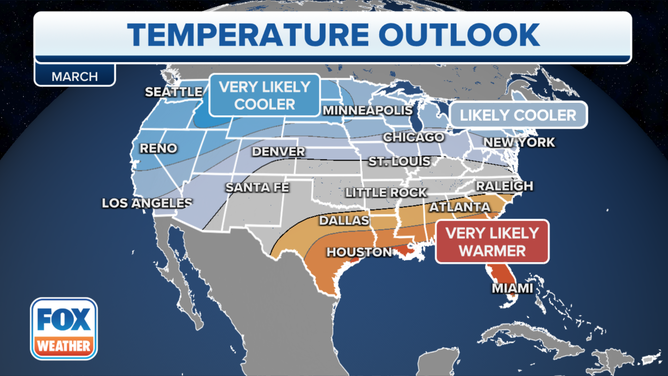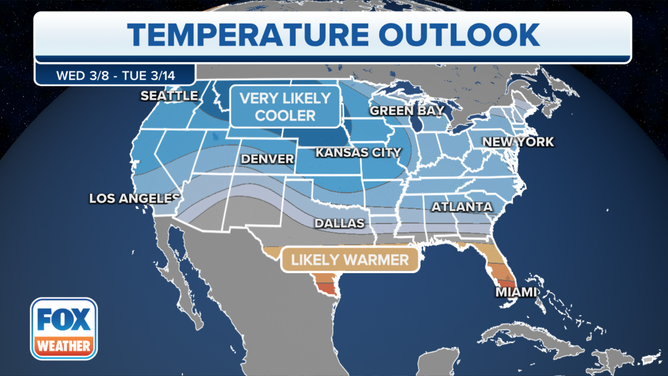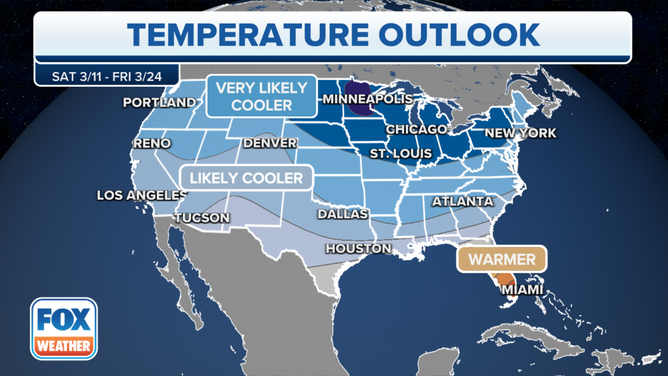March's temperature outlook: Swimsuits or mittens for the start of meteorological spring?
NOAA's Climate Prediction Center released its monthly temperature outlook for March, and it is trending colder for much of the country.
Temperature outlook shows continued heat for the South and Chill for the West and Northeast
Looking ahead to March the South will continue to bake in near record high temperatures. The northern tier, especially the Northwest and Northeast will likely be below normal.
Punxsutawney Phil's prognostication of six more weeks of winter seems to align with a more scientific approach. NOAA's Climate Prediction Center released its monthly temperature outlook for March. The Northwest and Northeast will likely be colder than average. Only the Southeast and western Alaska have a good chance of being warmer than average this month.

March temperature outlook from NOAA's Climate Prediction Center.
(FOX Weather)
After many cities experienced the warmest January on record and a warm February, NOAA feels things will cool down for the start of meteorological spring.
NOAA meteorologists expect a pattern change, especially in the second two weeks of the month. The cooling trend will take place following a recent sudden stratospheric warming event, which is a shift in the polar vortex.
A planetary wave in the troposphere at the end of January gave the polar vortex a minor bump from below, which caused some rapid but modest warming, NOAA scientists explained. That event likely destabilized the polar vortex enough that a weaker disturbance in the stratosphere about a week later triggered a total disruption and sudden stratospheric warming event, they said.
"What the disruption will mean for weather down here in the troposphere is still uncertain, but sometimes these events lead to extreme cold air outbreaks in the mid-latitudes of the United States," NOAA said in a blog post a few weeks ago.
SUDDEN STRATOSPHERIC WARMING, POLAR VORTEX DISRUPTION COULD MEAN COLDER WEATHER FOR EASTERN US

Temperature outlook valid from March 8-14 issued by NOAA's Climate Prediction Center.
(FOX Weather)
"A disrupted polar vortex tends to have its strongest tropospheric impact over the North Atlantic, which increases the odds for colder conditions across the eastern United States or northern Eurasia. But it’s not the only influence out there," NOAA said in the blog post. "Other phenomena like La Nina, the Madden-Julian Oscillation or the chaotic nature of the atmosphere can also affect how our atmosphere reacts to a disruption of the stratospheric polar vortex."
And NOAA noted in its March outlook discussion that the Madden-Julian Oscillation is going through phases that "favors below-normal temperatures to expand eastward to include the north-central and eastern U.S. after the first week of March."
NOAA's outlook maps show that about three-quarters of the U.S. has a 50% to 60% chance of below-average temperatures in March. A good chunk of the northwestern U.S. has a 70% to 80% chance of being colder than average.
That cold pool shifts east during the third week of March. The northern Plains, Midwest and interior Northeast have a 70% to 80% chance of colder-than-average temperatures.

Temperature outlook valid from March 11-24 issued by NOAA's Climate Prediction Center.
(FOX Weather)
NOAA stated that the cooling will come in the form of cold-air outbreaks rather than a stagnant air mass. Even so, it warned of a risk to early-blooming vegetation over portions of the Southeast and mid-Atlantic.
Only Florida and the immediate Gulf Coast have a 50% to 60% chance of warmer-than-average temperatures. The rest of the Southeast and western Alaska are in the 33% to 60% range for above-average temperatures.
NOAA said in its seasonal forecast discussion that the central Plains, Ohio Valley, mid-Atlantic and southern Plains will start out warm in March and then end warm, but they will have periods of cold during the middle weeks of the month. That will average out to typical March temperatures when looking at the month as a whole.
